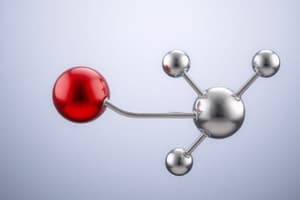Podcast
Questions and Answers
What is the coordination number of a sphere in a cubic close-packed structure?
What is the coordination number of a sphere in a cubic close-packed structure?
- 4
- 8
- 12 (correct)
- 6
How many octahedral holes are present per sphere in a close-packed array?
How many octahedral holes are present per sphere in a close-packed array?
- Four
- Two
- Three
- One (correct)
What is the packing efficiency of a close-packed arrangement?
What is the packing efficiency of a close-packed arrangement?
- 60%
- 52%
- 80%
- 74% (correct)
In a body-centered cubic (bcc) arrangement, what is the coordination number of each sphere?
In a body-centered cubic (bcc) arrangement, what is the coordination number of each sphere?
Which of the following accurately describes the relationship between the ABABAB sequence and hcp?
Which of the following accurately describes the relationship between the ABABAB sequence and hcp?
What is the feature of the tetrahedral holes in relation to octahedral holes in a close-packed structure?
What is the feature of the tetrahedral holes in relation to octahedral holes in a close-packed structure?
What can be said about the arrangement of close-packed layers in cubic close-packing?
What can be said about the arrangement of close-packed layers in cubic close-packing?
How many spheres are present in a simple cubic unit cell?
How many spheres are present in a simple cubic unit cell?
What key feature distinguishes metallic solids from ionic solids in terms of bonding?
What key feature distinguishes metallic solids from ionic solids in terms of bonding?
Which type of packing arises from the ABABAB... arrangement of layers?
Which type of packing arises from the ABABAB... arrangement of layers?
In a close-packed structure, how are the spheres in the second layer arranged relative to the first layer?
In a close-packed structure, how are the spheres in the second layer arranged relative to the first layer?
What is the typical percentage of space occupied in a close-packed arrangement of spheres?
What is the typical percentage of space occupied in a close-packed arrangement of spheres?
Which of the following statements is true regarding ionic solids?
Which of the following statements is true regarding ionic solids?
What type of crystal structures do metals form?
What type of crystal structures do metals form?
In terms of bonding character, how is ionic bonding typically characterized in solids?
In terms of bonding character, how is ionic bonding typically characterized in solids?
What occurs in the packing of spheres when adding a third layer in a close-packed arrangement?
What occurs in the packing of spheres when adding a third layer in a close-packed arrangement?
Flashcards are hidden until you start studying
Study Notes
Introduction to Metallic and Ionic Solids
- Metallic and ionic solids form ordered arrays of atoms or ions and have crystalline materials with lattice structures.
- Metallic solids have strong covalent bonding through delocalized electrons, explaining their high electrical conductivity.
- Ionic solids are bound by electrostatic interactions between oppositely charged ions, resulting in their insulating properties.
- Bonding can have mixed character, with ionic contributions to covalent bonds and covalent character in predominantly ionic compounds.
Packing of Spheres
- Close packing maximizes space utilization, achieving approximately 74% occupancy.
- Each sphere in the same layer of a close packed arrangement is in contact with six others.
- The second layer occupies the hollows formed by the first layer, with two types of hollows available.
- The third layer can be arranged in either ABCABC or ABAABA patterns, leading to different close-packed arrangements.
Hexagonal and Cubic Close Packing
- Hexagonal close packing (hcp) follows an ABABAB... pattern.
- Cubic close packing (ccp) follows an ABCABC... pattern.
- Both hcp and ccp arrangements have a coordination number of 12, meaning each sphere is surrounded by 12 nearest neighbors.
Unit Cell in Hexagonal and Cubic Close Packing
- A unit cell is the smallest repeating unit of a crystal structure.
- Cubic close packing is also referred to as face-centered cubic (fcc) packing.
- The hcp unit cell consists of parts of three ABA layers.
- The ccp unit cell's close-packed layers are not parallel to the base but lie along the body-diagonal of the cube.
Octahedral and Tetrahedral Holes
- Close packed structures contain octahedral and tetrahedral holes, which are sites where additional atoms or ions could reside.
- There is one octahedral hole per sphere and twice as many tetrahedral holes in a close packed array.
- Octahedral holes are larger than tetrahedral holes.
Non-Close Packing - Simple Cubic vs. Body-Centered Cubic Arrays
- Unlike close packing, non-close packing arrangements are less efficient in space utilization.
- Simple cubic arrays have a coordination number of 6, with each sphere touching six others.
- Body-centered cubic (bcc) arrays are formed when a sphere is placed inside the hole of a simple cubic array.
- Bcc arrays have a coordination number of 8, with each sphere touching eight others.
Worked Example: Packing Efficiency in Simple Cubic Arrays
- A simple cubic unit cell contains one sphere.
- Approximately 52% of the volume of a simple cubic unit cell is occupied by spheres.
Studying That Suits You
Use AI to generate personalized quizzes and flashcards to suit your learning preferences.



